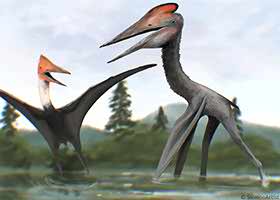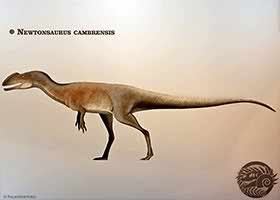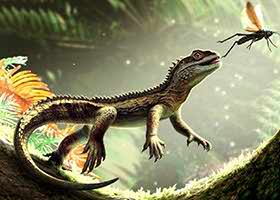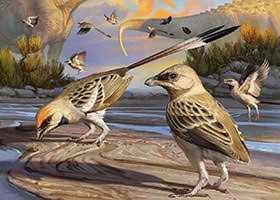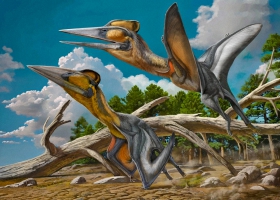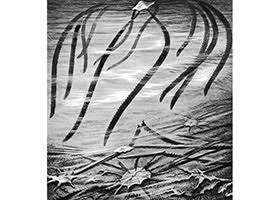
New ethological classes provide a closer look at the behaviors recorded in trace fossils. These categories capture a variety of activities, from aestivation and pupation to strategies like trapping prey, refining the behavioral framework originally proposed for ichnology.
Recent Additions to the Behavioral Classification of Fossil Traces
In 1996, Bromley published a classification scheme for fossil traces based on animal behavior. He added seven ethological classes to the five classic ones introduced by Seilacher in 1953.
Since then, paleontologists have suggested several new ethological classes of trace fossils to describe behaviors that the original system did not encompass. These additions reflect a growing understanding of the diversity of organism-sediment interactions preserved in the fossil record. In some cases, the behavior of trace makers is so distinctive that paleontologists should use subcategories of new ethological classes. They should especially do this when interpreting certain environments ecologically, where an organism’s behavioral traits may be the most important factor.
New Ethological Classes
The expanded classification of new ethological classes includes traces related to molting, pupation, digestion, and other specialized activities, offering a more nuanced framework for interpreting fossilized behavior across various environments and geological periods. Ichnologists already use some of these ethological groups, while others are subcategories of well-established classes.
Aestivichnia

Aestivichnia. Traces of aestivation. These are interpreted as aestivation chambers (used for summer dormancy or diapause) created by earthworms, insects, and mollusks. This group also includes aestivation burrows of lungfish, amphibians, and certain reptiles. Estivation helps organisms survive during hot or dry periods. New ethological classes such as Aestivichnia illustrate behaviors related to survival during adverse conditions, preserved as distinct fossil structures.
The chambers are spherical or slightly egg-shaped, with multilayered walls lined with imbricated pellets and filled with rounded or meniscate pellets arranged in winding strands. Secondary chambers and emergence holes are absent. Modern earthworms make similar chambers.
Aestivichnia falls under the subcategory of Domichnia because trace makers construct these structures to protect themselves from temporary deteriorations in local environmental conditions.
Examples: Castrichnus incolumis; Edaphichnium lumbricatum, Late Jurassic and Late Cretaceous1; and modern estivation chambers from Spain: Hormogaster elisae, Martiodrilus heterostichon.2
Calichnia

Calichnia. Brooding traces. These are structures created by organisms specifically for breeding purposes, such as honeycomb cells. They include traces made by adult individuals during the rearing and care of young of the same species—ranging from protecting offspring to maintaining a stable microclimate, like consistent humidity and temperature. Among the new ethological classes, Calichnia reflects reproductive strategies evident in the fossil record.
The burrows may be simple or complex, but they typically consist of one or more chambers. Tunnels for adult access can connect these chambers, and they may also have much smaller exit holes or tunnels for the young.
Calichnia is usually preserved in full relief. Vertebrate nests can range from shallow pits to small mounds, tunnels, or classic “bird nests” constructed from twigs.
The spelling Calcihnia is a common misspelling and is not recognized in scientific literature.
Examples: Celliforma, Cellicalichnus, Coprinisphaera, Scaphichnium, Quirogaichnus, and Termitichnus.

Celliforma are fossilized larval chambers created by burrowing bees or other types of hymenopteran insects. These flask- or capsule-shaped chambers have smooth outer and inner walls and often radiate around a central shaft.
They can contain fossilized pollen and spores. Some chambers have a distinctive spiral cap. Interestingly, the earliest examples of Celliforma date back to the Triassic period, which is before the appearance of the first known flowering plants. This indicates that the creatures that made them were not involved in pollination.
Celliforma occur in various types of continental soil environments, but not in swamps or lakes, and belong to the Coprinisphaera Ichnofacies.
Digestichnia

Digestichnia. Digestion traces. This category encompasses all types of traces formed because of the digestive process. The term refers to modifications of material processed within the digestive tract of the trace maker, in contrast to the descriptive term “bromalite,” which denotes fossilized digested remains. Within the framework of new ethological classes, Digestichnia documents evidence of the characteristics of digestive processes. These traces include coprolites, regurgitalites, cololites, and gastrolith modifications.
Digestion traces are commonly present in fossil records from both terrestrial and marine environments.

Coprolites, generally the most widespread, consist of a fecal matrix and may contain fossilized body parts (hard remains of prey) or plant matter.
Regurgitalites, produced mainly by vertebrates (such as reptiles, birds, and fish) and some mollusks through regurgitation, consist solely of prey remains (partially digested bones and shells) or sediment particles.

Cololite (cololith) are fossilized intestinal contents that remain within the body cavity, preserved after the organism itself decomposes. For example, the trace fossil formally named Ambergrisichnus.
Gastroliths are a group that includes:
Biogastroliths—biologically formed stones.
Patho-gastroliths—pathological stones, such as bezoars. A bezoar is a hard mass formed in the gastrointestinal tract from undigested or indigestible material, including tightly packed hair or plant fibers.
Geo-gastroliths—geological stones swallowed for digestion or buoyancy. They include stones, concretions, and other materials swallowed either intentionally or accidentally. However, while the stones themselves are not fossilized traces, digestive processes cause surface changes such as abrasion and etching by stomach acids and enzymes, which scientists consider fossil traces.
Ecdysichnia

Ecdysichnia. Moulting traces. Shedding of the old cuticle (exoskeleton) is part of the life cycle of many invertebrates. New ethological classes such as Ecdysichnia refer to traces of molting, defined as evidence of behavior associated with ecdysis—not merely the remains of exuviae. This category includes traces left by animals during shedding, pupation, or molting, such as arthropods discarding their exoskeletons or insects constructing pupation chambers.
Among fossil traces, the most recognizable examples are insect pupation and arthropod molting. Trilobites often pressed themselves into mud to anchor their old exoskeletons and facilitate emergence. Some ichnospecies of Rusophycus, traditionally interpreted as resting traces, are now sometimes reinterpreted as molting traces.
Modern arthropods, on the other hand, have more complex molting behaviors. Decapods, for example, twist and turn to shed their cuticle, while other arthropods spin or rub against sediment or solid objects. These behavioral differences complicate the ichnotaxonomic classification of such traces.
Pupation traces, known as Pupichnia, form a subcategory of these new ethological classes, showing how organisms prepared for metamorphosis. These structures, which typically resemble burrows, allow us to distinguish them from other trace fossils, such as Calichnia. Molting traces may range from superficial substrate disturbances—transitional to Cubichnia—to burrow-like subterranean structures.
Examples of these are Rusophycus and several ichnogenera that scientists haven’t formally described or confirmed, such as Exuvioichnus, Harpichnus, and Marasuichnus.
Impedichnia

Impedichnia. Embedment traces. Impedichnia, one of the new ethological classes, captures interactions like bioclaustration, also known as embedment structures. These structures form because of symbiotic relationships where the growth of one organism alters another’s growth. Contrary to bioerosional organisms that actively penetrate the substrate, neither the host nor the invader modifies the material itself. Instead, the interaction leads to changes in the host’s skeletal growth to accommodate the invader.
Two distinct behavioral patterns result in the formation of Impedichnia:
The endosymbiont suppresses the host’s skeletal growth through its activity.
The host alters its skeletal growth to surround or adapt to the invading organism.
Although conceptually similar to Domichnia (dwelling traces), Impedichnia is excluded from this category and from other classifications of trace fossils, along with structures such as plant galls caused by wasps or skin infections caused by microorganisms. These structures more likely represent body fossils than trace fossils.
For this reason, some researchers have proposed replacing the term “impedichnia” with “impeditaxa” to more neutrally describe these symbiotic structures.
Examples: Anoigmaichnus, Caupokeras, Chaetosalpinx, Eodiorygma, Helicosalpinx, Hicetes, Klemmatoica, and Tremichnus.

Caupokeras is a bioclaustration structure categorized as Impedichnia. It results from the symbiotic fusion of two bryozoan host species—Leioclema elegans and Loxophragma leptum—with a soft-bodied modular symbiont, likely a hydrozoan. As the symbiont settles and develops on living bryozoan colonies, it induces the formation of tubular structures with terminal openings. These features are absent in non-symbiotic bryozoans and disrupt the normal growth pattern of the host colony, thereby modifying the living substrate.
Geological context: Early Devonian (Emsian), Aguión Formation, Asturias, northwestern Spain.
Irretichnia

Irretichnia. Trapping traces. This type of fossil trace is associated with the capture of prey using traps. Prey capture for feeding is a specialized form of predation. These traces reflect the behavior of predators that do not pursue their prey directly but instead construct specific structures to lure and ensnare it. Such traps may include webs, sticky substances, or pits into which prey can fall.
Unlike typical hunting behavior, the predator here does not actively search for or overpower the prey but waits for it at a pre-prepared trap.
Among new ethological classes, Irretichnia stands out as a subcategory of Praedichnia. However, it differs by the active construction of a trap, rather than mere ambush or pursuit. These new ethological classes reveal predatory strategies beyond direct hunting. If an animal uses its burrow solely as a hiding spot and does not modify it for capture, then researchers do not classify it as Irretichnia. Conversely, if the predator actively hunts, such traces fall under classical Praedichnia.
Trap traces in the fossil record are extremely rare. The most well-known examples include spiderwebs preserved in amber, which document the behavior of spiders as trappers.
Middle Devonian: Among the earliest possible trap traces. Early and Middle Cretaceous: Finds in Burmese amber. Eocene: Baltic amber. Miocene: Amber from Bitterfeld (Germany) and the Kaliningrad region (Russia).

Some sedimentary structures are traps created by animals. For instance:
Ant-lion burrows: Funnel-shaped pits resembling modern ant-lion traps (Devonian).
Scorpion pits: Extremely rare, known only from the Pleistocene (Sonora, Mexico).
Cerianthid tube anemone burrows: Marine anemone burrows used to trap trilobites (e.g., the predatory anemone Dolopichnus gulosus from the Cambrian used its burrow as a trap to catch and consume trilobites).
Echiuran worm burrows: Burrows of worms such as Diplocraterion parallelum (Late Quaternary, New Zealand); some Arenicolites are also interpreted as traps.
Graphoglyptids: Geometrically complex deep-sea structures that may have functioned as traps, among other purposes (e.g., Spirorhaphe). (Lehane & Ekdale, 2013).
Examples: Altichnus, Arenicolites, Bergaueria, Conichnus, Conostichus, Diplocraterion parallelum, Dolopichnus gulosus, Monocraterion, Spirorhaphe.
Mortichnia

Mortichnia. Death struggle traces. The final walk, the marks of a fatal struggle, and the evidence of an organism’s demise. This type of ichnofossil (traces of life activity) represents impressions left by an organism immediately before its death. Within new ethological classes, Mortichnia refers to traces of terminal struggle, originally called taphoglyphs, first discovered in the Solnhofen limestones (Late Jurassic, Germany).
Any trace maker may face sudden death—due to predation, adverse environmental conditions, or disease.

However, many examples, such as Ecdysichnia (traces ending in exuviae), do not qualify as true Mortichnia. In fact, genuine Mortichnia are rare (e.g., Telsonichnus, spiral or looped traces left by bivalves like Solemya). We can confidently attribute structures reflecting an organism’s final movements to the maker of Mortichnia only if the trace ends with a fossilized body. Without preserved terminal remains, accurate identification of Mortichnia is impossible.
For this reason, use of the category is discouraged. Mortichnia is often confused with Mordichnia—traces of biting and gnawing.
In most cases, scientists reassign this category to Repichnia, Praedichnia, and Ecdysichnia, but Mortichnia remains one of the most striking among the new ethological classes.
Examples: Kouphichnium, Telsonichnus and Vadichnites.

Kouphichnium. Trace fossils of horseshoe crabs that record the characteristic marks left by the animal’s limbs as it crawled across the substrate.
The most famous and classical example of Mortichnia traces is Kouphichnium walchi, attributed to the horseshoe crab Mesolimulus walchi, found in the Solnhofen limestone of Germany. These fossil traces clearly show the path of the horseshoe crab as it moved along the seafloor, ending abruptly at the location of the fossilized body of the animal itself. This indicates that the creature left the traces and then died, with its body preserved in place.
Thus, the Kouphichnium walchi trace combines elements of Repichnia (locomotion trace) and Mortichnia (death struggle trace).
Movichnia
Movichnia. Moving traces. A supercategory used to classify fossil traces resulting from the active movement of organisms. It encompasses nearly all types of locomotion and includes four subgroups: Natichnia, Cursichnia, Repichnia, and Volichnia.
Essentially, this category is equivalent to the more familiar term “Repichnia,” which renders Movichnia redundant. As a result, it has not gained widespread acceptance and has found little use in practical ichnological classification. Still, its mention among new ethological classes illustrates the challenges of expanding classification without duplicating existing concepts.
Navichnia

Navichnia. These are traces left by animals moving within the sediment itself. Some creatures don’t just crawl or burrow—they swim through soft, soupy mud (known as soupground). Unlike traditional burrows or tunnels, these movements don’t leave behind clear structures. Instead, they disrupt the sediment layers, creating blurry, mixed-up patterns called diffuse bioturbation. Scientists refer to these subtle signs as Navichnia and recommend classifying them as a subcategory of Repichnia—a broader group of locomotion traces. When discussing it in connection with new ethological classes, behavior adapted to unstable sediments is decisive.
Pupichnia

Pupichnia. Pupation traces. These are structures created by insects to protect themselves during pupation. Fossilized pupation traces typically show passive infilling, whereas more recent examples lack such filling. Pupation chambers are usually constructed from the inside, thus resulting in walls that are smooth on the interior but rough or granular on the exterior. Pupichnia structures differ from similar ones known as Calichnia.
This behavior is characteristic of only a few of insect species, since pupation within cocoons, pupae, or puparia is far more common. The same individual that creates a Pupichnia structure later emerges from it, albeit at a different developmental stage—unlike Calichnia, where one or more adult insects build the structure for their offspring.
Pupichnia, considered a subcategory of Ecdysichnia, plays an important role among new ethological classes documenting ontogenetic behaviors—life-stage transitions preserved as trace fossils.
Examples: Fictovichnus, Pallichnus, and Rebuffoichnus.

Teisseirei. A concretion contains a mold shaped like an elongated chamber. Some of these chambers include a pre-chamber or a multilayered lining. The inner surface displays a texture of densely packed pits. The internal sediment is very fine- to fine-grained, while the surrounding matrix consists of medium- to coarse-grained sand.
This structure represents a shallow pupation chamber of a sphinx moth, embedded in paleosol. It occurs in terrestrial, continental paleoenvironments, typically within the upper horizons of paleosols. Geological range: Eocene to recent.
New Ethological Classes That Did Not Gain Recognition
Over the years, researchers have proposed several additional behavioral categories for trace fossils. However, the ichnological community quickly dismissed most of these ideas. Below are some of the most notable ones that were either completely rejected or received partial recognition.
Chemichnia

Chemichnia. Traces of chemosymbiosis. Chemichnia are trace fossils formed by animals that lived in partnership with chemoautotrophic bacteria. These creatures, typically burrowers, relied on their microbial symbionts to generate energy. The burrow structures often reflect the chemical gradients between oxidizing and reducing layers in the sediment, thus serving the needs of both the animal and its bacterial partners. The bacteria harness chemical reactions in the surrounding substrate, especially those involving oxygen and compounds like sulfide, ammonium, hydrogen sulfide, or methane.
Openings at the sediment surface connect Chemichnia to oxygen-rich water. To access chemical compounds, organisms burrow deeper into anoxic layers, reaching zones rich in sulfates and ammonium—essential for microbial respiration. Their burrows frequently exhibit a Y-shaped structure, common among bivalves (e.g., Lucinidae, Thyasiridae, and Solemyidae), featuring a deep vertical shaft for chemical access, while the mollusks themselves inhabit the upper part of the burrow. Regular branching enhances both surface area and the inflow of mineral-bearing pore water.
Many of these burrows had a Y-shape, especially those made by bivalves like Lucinidae, Thyasiridae, and Solemyidae. The deep shaft reached the chemical-rich zones, while the mollusk lived closer to the surface. Branching tunnels helped increase the flow of mineral-rich pore water and expanded the surface area for microbial activity.
Interestingly, the sediment inside these burrows often looks different—either in color or composition—because of the organic material involved. In fact, while many burrowers might leave similar traces, scientists usually rely on indirect clues like pyrite deposits or unique burrow shapes to identify true Chemichnia. Today, ichnologists widely accept Chemichnia as a subtype of Agrichnia.
Examples: Chondrites, Trichichnus. It is possible that chemosymbiosis was characteristic of certain deep-sea forms of Zoophycos and Polykampton.
Cecidoichnia

Cecidoichnia. Plant reaction tissue. Cecidoichnia is a term originally proposed to describe how plant tissues physically change when they interact with other organisms like insects, bacteria, fungi, or even other plants. A common example is the formation of galls—those strange, abnormal, swollen growths you might spot on leaves or stems.
For instance, imagine an insect laying eggs inside a leaf. In response, the plant grows a protective bump around the eggs. That bump is called “reaction tissue”—a kind of built-in defense system. It’s the plant’s way of reshaping itself to deal with the intrusion.
But here’s the twist: scientists now recommend using the term “cecidotaxa” instead. Why? Because animals don’t always cause these changes directly, they don’t meet the strict definition of trace fossils. Instead, scientists regard them as part of the plant’s body—more a biological response than a behavioral imprint. (Bertling et al., 2006).
Cibichnia

Cibichnia. Feeding traces. Cibichnia is a proposed supercategory that encompasses all trace fossils related to feeding behavior. It includes Seilacher’s established categories: Fodinichnia (feeding burrows), Pascichnia (grazing traces), and an additional group, Mordichnia (predation traces).
However, this supercategory was never widely accepted, as it provides no additional ethological insight and is essentially equivalent to the existing use of Fodinichnia. For this reason, ichnologists prefer to stick with Seilacher’s classical ethological classifications.
Corrosichnia

Corrosichnia. Plant-induced corrosion traces. Among plant-related trace fossils, Corrosichnia refers to surface-level chemical dissolution of hard substrates, primarily driven by biochemical processes. Most known examples come from the modern period and include features like small pits formed by lichens and corrosive root structures left behind as plant roots chemically interact with surrounding sediments.
These traces likely form as plants extract minerals directly from the substrate, enhance soil formation, or anchor themselves more securely in the ground.
Rhizocretions. Scientists classify fossilized root structures like rhizocretions and other types of rhizoliths within Corrosichnia. These structures represent the physical evidence of how plant roots corroded their environment over time.
Cursichnia

Cursichnia. Walking traces. Cursichnia refers to traces left by walking or running animals—distinct from crawling or creeping traces. Paleontologists introduced this subgroup within Repichnia to distinguish movement traces made by limb-bearing tracemakers (like footprints or trackways) from those created by organisms that move by crawling (Repichnia in the strict sense).
These traces typically consist of repeated sets of discrete imprints that reflect the limbs and locomotion patterns of the tracemakers on the substrate. Examples include the footprints of vertebrates like Chirotherium, the tracks of small predatory theropod dinosaurs such as Grallator, and arthropod trackways like Diplichnites and Stiaria.
Cursichnia falls under the broader ethological category Repichnia, according to general paleontological consensus.
Gradichnia

Gradichnia. Walking traces. Gradichnia refers to tracks and trackways left by walking animals. This category essentially overlaps with Cursichnia, which also describes locomotion traces made by limb-bearing organisms. As a specific form of movement, Gradichnia fits within the broader ethological group Repichnia, making it somewhat redundant in classification.
Faecichnia

Faecichnia. Digestion traces Faecichnia includes trace fossils related to digestion, primarily coprolites (fossilized feces) of various types. It closely resembles the category Digestichnia but is more narrowly defined: Faecichnia includes only true fecal remains and regurgitalites (fossilized vomit), thereby excluding other digestive-related traces like gastrolith scratches or fecal matter preserved inside the digestive tract. Because of this narrower scope, Digestichnia is generally preferred in ichnological classification.
Today, the term “Faecichnia” is mainly used in the phrase “Faecichnia-ichnocoenosis,” referring to sediment granules reworked by crustaceans and polychaete worms.
Fixichnia

Fixichnia. Traces of attachment. Fixichnia refers to the marks left by sessile organisms—those that attach themselves to a hard surface and remain there for the rest of their lives. These structures closely relate to Domichnia, which represents dwelling traces. However, unlike Domichnia tracemakers, many organisms that create dwellings can abandon them and build new ones elsewhere. In contrast, Fixichnia reflects permanent attachment.
Most attachment traces show evidence of the substrate being roughened—either mechanically or chemically—to help the organism grip the surface more effectively. Organisms achieve this anchoring using either soft tissues or hard body parts like an exoskeleton. The resulting structures are typically shallow surface impressions preserved as negative epichnia.
The shapes of these traces vary widely: from concentric furrows (Centrichnus) to tiny radial pits (Podichnus), kidney-shaped marks (Renichnus), star-like patterns (Stellichnus), and even sinuous grooves left by modern polychaete worms on pebbled surfaces.
Among proposed ethological categories, Fixichnia is one of the most promising candidates among new ethological classes for formal recognition as a distinct behavioral class.
Examples: Anellusichnus, Centrichnus, Lacrimichnus Leptichnus, Loxolenichnus, Podichnus, Renichnus, and Stellichnus.
Insolidichnia
Insolidichnia. Traces in unconsolidated substrate. The term “Insolidichnia” literally means “traces in unconsolidated material.” It refers to marks left by organisms that lived within or on the surface of soft, loose sediments—without constructing permanent, reinforced burrows or structures. These traces are often ephemeral and typically preserved only under very specific conditions, such as rapid burial.
In this context, Insolidichnia stands in contrast to Firmichnia (traces in stiffgrounds) and Hardichnia (traces in hardgrounds), forming part of the broader conceptual framework that distinguishes substrate consistency: softground–firmground–hardground. This interpretation aligns with the etymology and classification system developed to characterize substrate firmness, as seen in the work of Frey & Pemberton (1984).3

Alternate interpretation: Bioerosion traces.
There is another interpretation of Insolidichnia—as a term for bioerosion traces. These marks of erosion on hard substrates are further classified based on behavioral intent; for example, paleontologists classify a boring made for dwelling as a Domichnia, while they classify one made for feeding as a Fodinichnia. This usage appears in the literature of Geyer (1973)4 and Zwenger et al. (1986). In fact, what matters is not where the mark was left, but why.
Classification Note: It seems that someone proposed or used Insolidichnia in isolated contexts, but the ichnological community has not formally accepted it as a standard ethological category. Therefore, its use is generally discouraged in formal classification. Finally, while not widely adopted, Insolidichnia occasionally appears in discussions of new ethological classes, underscoring ongoing debate about substrate-based categories versus behavior-based definitions.
Mordichnia

Mordichnia. Biting and gnawing traces. Mordichnia encompasses feeding traces produced through biting, rasping, or gnawing. These marks, often preserved on the remains of prey like bones or shells, come from not only vertebrates but also certain invertebrates. For example, arthropods may cut into the shells of gastropods, while gastropods themselves scrape algae from hard surfaces.
Some instances of Trypanites and Oichnus, interpreted as predator-made borings, may also fall under Mordichnia. Similarly, gnaw marks on fossilized wood—left by ancient rodents or insects—can be considered examples of this category. These traces record the physical action of an organism chewing or biting into a substrate, typically to obtain food or access something within.
Classification Note: While Mordichnia has descriptive value, scientists generally view it as an unnecessary category. In ichnological classification, paleontologists consider the purpose of feeding more important than the specific method used. Therefore, it’s better to group such traces under broader ethological categories like Praedichnia (predatory feeding traces) and Pascichnia (grazing traces). Although typically reassigned to broader predatory classes, Mordichnia demonstrates how some proposed new ethological classes sought to capture specific feeding mechanisms.
Natichnia

Natichnia. Swimming traces. Natichnia refers to trace fossils formed by animals swimming just above the seafloor or hovering close to it. As they move, their fins, tails, or other extremities occasionally brush against the sediment surface, leaving behind delicate, wavy lines.
These traces are typically preserved as positive hyporeliefs (raised impressions on the underside of a sediment layer) and less commonly as negative epireliefs (depressions on the top surface). A well-known example of Natichnia comes from Glenisla, Australia.
In ichnological classification, paleontologists consider Natichnia either a notable behavioral variation or a subcategory within Repichnia, which broadly includes locomotion-related traces.
Examples: Albertasuchipes, Characichnos, Hatcherichnus, Lunichnium, Mesosaurichnium, Undichna.

Undichna. Fossil traces of swimming fish. Undichna belongs to the ethological class Natichnia, which includes traces formed by swimming behavior. It is the most well-known example of a trace fossil left by fish.
These traces typically appear as a single sinusoidal wave or as multiple interwoven wave patterns—sometimes asymmetrical—etched into the sediment as the fish’s body or fins brushed against the substrate.
An extinct group of jawless fish called cephalaspids made the oldest known Undichna traces. These fossils date back to the Early Devonian period, around 400 million years ago, and researchers discovered them in an ancient riverbed near the border of England and Wales.
Such swimming traces occur in both Paleozoic and Mesozoic deposits, offering a glimpse into the locomotion of ancient aquatic life across vast spans of geological time.
Polychresichnia

Polychresichnia. Multifunctional trace fossils. Polychresichnia refers to trace fossils that reflect two or more distinct behavioral patterns. For example, a structure classified as Domichnia (dwelling trace) may also serve as a feeding site. These multifunctional traces often arise from complex behaviors, especially among social insects.
Such structures—frequently large and elaborate—can simultaneously represent various activities. Adult insects might defend them while raising offspring, use them as living and sleeping quarters, and shelter within them during adverse weather conditions.
Some researchers also include rhizocretionary structures within Polychresichnia. These are mineral accumulations (concretions or nodules) formed around plant roots. They function as anchoring points, facilitate nutrient and water uptake, and often involve symbiotic relationships with mycorrhizal fungi.
Classification Note: However, many ichnologists view Polychresichnia as an excessive or redundant ethological category. Since most trace fossils inherently reflect multiple behaviors, paleontologists consider overlaps and transitions between categories the norm rather than the exception. As a result, we typically reassign Polychresichnia to more established classes like Calichnia (resting traces) or Domichnia. While many ichnologists view this category as unnecessary, it reflects an attempt to adapt new ethological classes for complex behavior patterns.
Examples: Parawanichnus.
Quietichnia
Quietichnia. A proposed supercategory for stationary behavior, Quietichnia, encompasses two types of trace fossils: Domichnia (dwelling traces) and Cubichnia (resting traces). The rationale behind this grouping lies in the shared behavioral trait—both represent stationary activity, unrelated to active movement.
In these cases, the organism remains in one place: either temporarily resting (Cubichnia) or permanently inhabiting a specific location (Domichnia). The term “quiet” likely refers to the absence of locomotion.
Classification Note: However, ichnologists do not currently use Quietichnia in classification. They do not organize the main Seilacherian ethological categories into supercategories because they believe such groupings reduce descriptive precision.
Sphenoichnia

Sphenoichnia. Fossil traces of root penetration. Sphenoichnia refers to a category of trace fossils that we attribute to plants, and it ranks as one of the most common types of plant-related fossil evidence.
These traces form through the slow growth and penetration of roots and rhizomes into sediment. As the roots push through the substrate, they disturb it—a process known as bioturbation—thereby resulting in the formation of soil clasts (fragments) of various sizes between the root structures.
Such traces reflect the essential functions of roots: absorbing water and nutrients while anchoring the plant in the ground. Mikuláš (1999) proposed the term “Sphenoichnia” to classify these root bioturbation structures within the broader framework of ichnology.
Taphichnia

Taphichnia are trace fossils recording unsuccessful attempts by animals to escape burial beneath sediment. The behavior is essentially the same as in Fugichnia—rapid movement upward or away from encroaching sediment—but in these cases the organism failed to reach safety and perished.
Recognition of taphichnia typically relies on the presence of the animal’s body fossil within or at the end of the trace, most often in species with hard skeletal parts that fossilize readily. Soft-bodied organisms rarely leave such evidence, so their failed escapes may be indistinguishable from successful ones. In the absence of preserved remains, an apparent “lucky escape” trace could in fact represent a fatal event. For this reason, some ichnologists view Taphichnia as a special subset of Fugichnia rather than a distinct behavioral category.
Xylichnia

Xylichnia. Trace fossils in petrified wood. Organisms, typically insects or marine invertebrates, form these structures by boring into wood. The resulting traces often take the form of tunnels, galleries, or holes, created for feeding or reproduction.
The earliest wood-boring traces date back to the Middle Devonian and appear as small, branching tunnels. These resemble the burrows made by modern oribatid mites, known for their role in breaking down cellulose in forest ecosystems. In Paleozoic deposits, such tiny, pellet-filled borings dominate, with the first large, visible holes only emerging in the Permian.
In continental settings, wood-boring traces left by ancient organisms commonly occur in Late Carboniferous rocks. Interestingly, many of these borings were not made by insects but by tiny soil-dwelling mites—specifically oribatids. However, cockroaches and other insects that fed on decaying wood may have produced some of these.
The earliest potential beetle traces appear in fossilized Permian plants—particularly glossopterids, a plant group typical of ancient Southern Hemisphere forests. Still, confidently identified beetle borings appear later, in Triassic deposits from what is now Germany and the southwestern United States (Arizona and Colorado).
With the rise of the Mesozoic, the diversity of wood-boring traces increased dramatically. This surge coincides with the evolutionary expansion of beetles, which began exploiting wood as both a food source and shelter. By the Cenozoic, with the emergence of modern forest ecosystems, the variety of these traces reached its peak.
Xylichnia is a subcategory of Fodinichnia, a broader ethological class of trace fossils associated with feeding behavior. As part of proposed new ethological classes, Xylichnia highlights specialized plant-animal interactions extending back to the Paleozoic.
Examples: Asthenopodichnium, Cycalichnus, Paleobuprestis, Paleoscolytus, Paleoipidus, Stipitichnus, Teredolites, Xylokrypta, Xylonichnus.

Paleobuprestis. Shallow, branching channels etched into fossilized stumps of Archaeocalamites, an ancient plant from the Carboniferous period. These tiny tunnels—just 2–4 mm wide and up to 35 mm long—crisscross the wood in patterns resembling the feeding and reproductive behavior of modern buprestid beetles (Coleoptera). One side of the stumps shows significantly more boring, hinting at beetle activity concentrated in specific areas.
The trace fossil, named Paleobuprestis sudeticus, appears in upper Visean (Brigantian) sediments and marks the earliest known example of wood-boring beetle traces on a macroscale. These borings, called Xylichnia, suggest that wooded terrestrial ecosystems hosted complex insect-plant interactions far earlier than previously thought.

Teredolites. Borings made by bivalves. Teredolites are trace fossils created by bivalve mollusks—specifically the so-called “shipworms,” which bore into and break down wood floating in marine environments. These organisms carve out tunnels in submerged wood, typically lining them with calcareous tubes. Over time, sediment fills the cavities.
These borings are characteristic of the Teredolites Ichnofacies, a trace fossil assemblage dominated by wood-boring organisms that thrived in marine settings.

Xylokrypta. Insect refuge in fossil wood. Xylokrypta is a distinctive U-shaped or club-like boring found in petrified wood from the Late Triassic Chinle Formation of southern Utah. Its structure is notably complex: two shafts converge deep within the wood at a central chamber, part of which is filled with meniscate sediment—likely composed of digested wood material.
Essentially, Xylokrypta represents a large cavity partially packed with reworked xylem. This created a sheltered space that appears to have served as a refuge for an insect. A larva accessed the chamber through a narrow vertical shaft, suggesting a specific behavioral sequence: it bored into the wood, constructed the chamber, pupated, and eventually exited as an adult.
This pattern aligns perfectly with the life cycle of holometabolous insects—species that undergo complete metamorphosis. The trace was most likely left by ancient beetles from the Cupedidae family, which inhabited Triassic forests.
A Modern Look at Ancient Behavior: The Rise of New Ethological Classes
The concept of new ethological classes continues to shape how ichnologists interpret fossil behavior. By introducing categories such as Aestivichnia, Calichnia, Ecdysichnia, and Pupichnia, these new ethological classes help researchers describe specific behaviors that were previously difficult to classify.
Other concepts, such as Impedichnia, Irretichnia, and Fixichnia, highlight the need for classification systems to adapt as new discoveries emerge.
Some proposed new ethological classes, such as Polychresichnia or Insolidichnia, remain debated, reflecting the dynamic nature of ichnological taxonomy. Collectively, new ethological classes illustrate the growing sophistication in behavioral interpretation, offering an ever-expanding framework for understanding life’s traces in the geological record.
- Melchor et al., 2023. Early Cretaceous lepidosaur (sphenodontian?) burrows. ↩︎
- Verde et al., 2007. A new earthworm trace fossil from paleosols: Aestivation chambers from the Late Pleistocene Sopas Formation of Uruguay. ↩︎
- Frey, R.W. and Pemberton, S.G. (1984) Trace Fossil Facies Models. In: Walker, R.G., Ed., Facies Models, 2nd Edition, American Association of Petroleum Geologists, Tulsa, 189-207. ↩︎
- Geyer, O.F. (1973). Grundzüge der Stratigraphie und Fazieskunde, Band 1: Paläontologische Grundlagen 1, Das geologische Profil, Stratigraphie und Geochronologie. – 279 pp.; Stuttgart (Schweizerbart’sche Verlagsbuchhandlung). ↩︎












